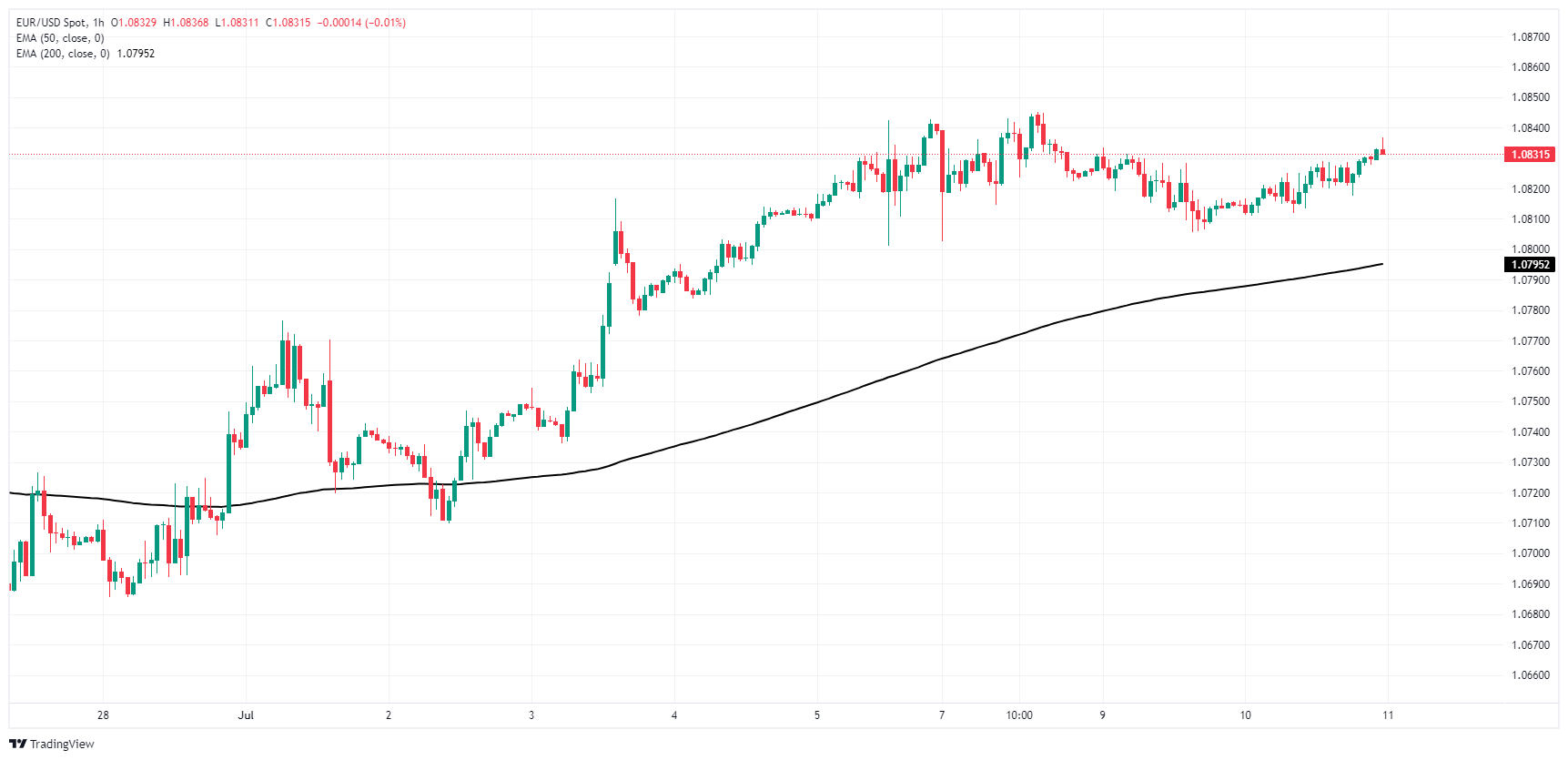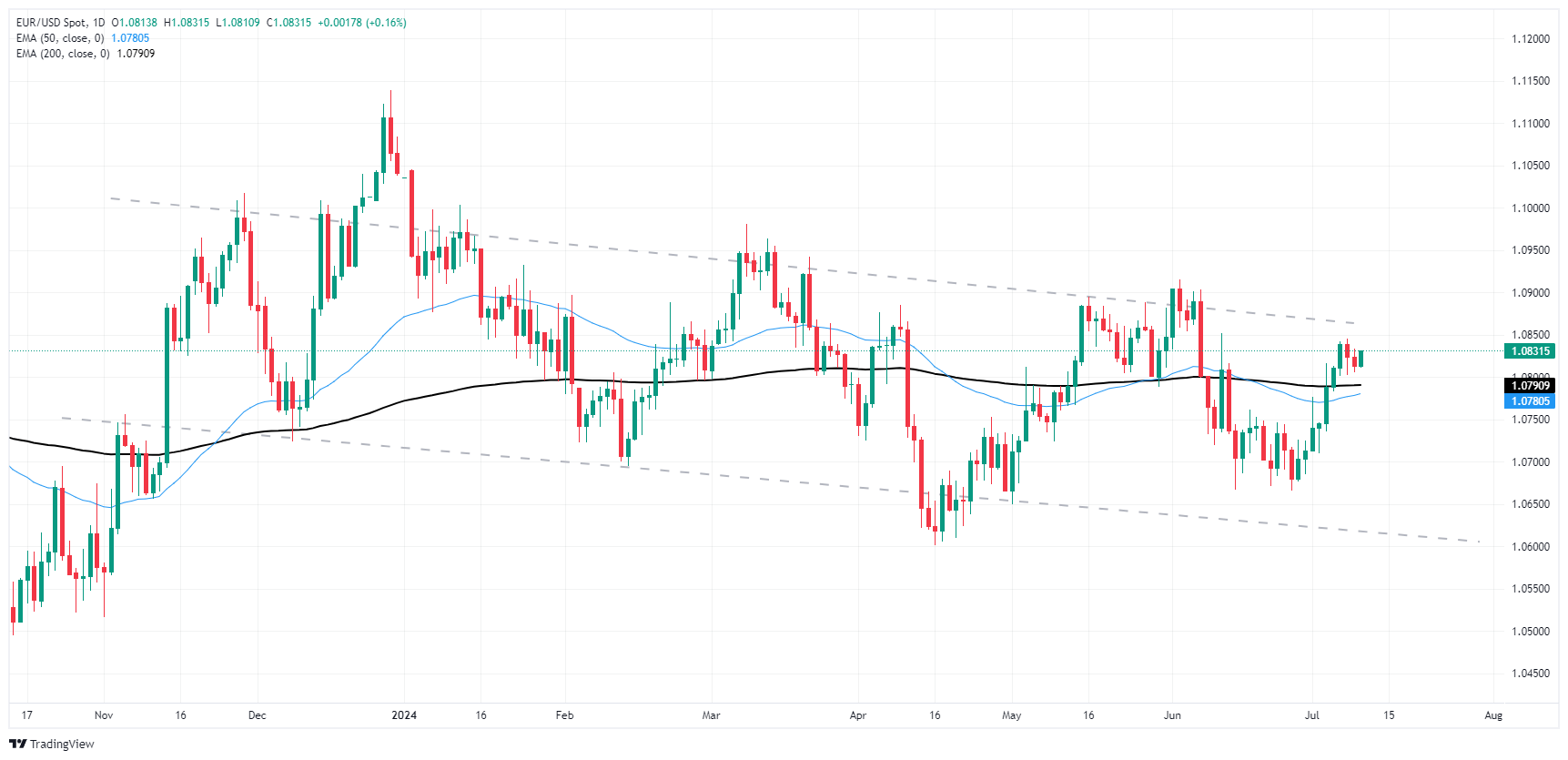- Аналітика
- Новини та інструменти
- Новини ринків
- EUR/USD gains ground as market sentiment leans back into rate cut expectations
EUR/USD gains ground as market sentiment leans back into rate cut expectations
- EUR/USD extended a recovery from the early week’s slump toward 1.0800.
- Rate cut expectations continue to drive broader market flows.
- EU data remains thin, US inflation figures to be key print for the week.
EUR/USD found some room on the high side on Wednesday, getting pushed up the charts by broad-market Greenback selling. Market sentiment has firmly recovered and leaned into renewed rate cut expectations after Federal Reserve (Fed) Chairman Jerome Powell gave his own version of a dovish appearance while giving two-day testimony to US Congressional committees. EU data remains thin outside of final German Harmonized Index of Consumer Prices (HICP) inflation slated for Thursday, and markets will be pivoting to face a double-header of key US inflation data due on Thursday and Friday.
Forex Today: Gearing up for US CPI
German final HICP inflation numbers are due during Thursday’s European market session, but little change is expected and the annualized figure for June is broadly expected to hold steady at 2.5%.
The markets, eager for a rate cut, interpreted Fed Chair Powell's appearances before Congressional committees as dovish this week. Powell cautiously acknowledged recent progress on inflation, prompting a recovery in risk appetite as investors once again hope for a rate cut in September. Investors will be watching for lower-than-expected US CPI inflation on Thursday, with the median market forecast expecting annualized core CPI inflation in June to remain at 3.4%.
Further US inflation data is scheduled for release on Friday, including the core US Producer Price Index (PPI) wholesale inflation. The index is expected to increase to 2.5% YoY from the previous 2.3%, which could impact broad-market rate cut expectations.
Euro PRICE Today
The table below shows the percentage change of Euro (EUR) against listed major currencies today. Euro was the strongest against the Canadian Dollar.
| USD | EUR | GBP | JPY | CAD | AUD | NZD | CHF | |
|---|---|---|---|---|---|---|---|---|
| USD | -0.01% | -0.03% | -0.05% | -0.02% | -0.06% | -0.09% | -0.05% | |
| EUR | 0.01% | -0.01% | -0.02% | 0.02% | -0.03% | -0.06% | -0.03% | |
| GBP | 0.03% | 0.00% | -0.02% | 0.02% | -0.03% | -0.07% | -0.01% | |
| JPY | 0.05% | 0.02% | 0.02% | 0.02% | -0.01% | -0.08% | 0.00% | |
| CAD | 0.02% | -0.02% | -0.02% | -0.02% | -0.06% | -0.10% | -0.03% | |
| AUD | 0.06% | 0.03% | 0.03% | 0.01% | 0.06% | -0.04% | 0.02% | |
| NZD | 0.09% | 0.06% | 0.07% | 0.08% | 0.10% | 0.04% | 0.06% | |
| CHF | 0.05% | 0.03% | 0.00% | -0.01% | 0.03% | -0.02% | -0.06% |
The heat map shows percentage changes of major currencies against each other. The base currency is picked from the left column, while the quote currency is picked from the top row. For example, if you pick the Euro from the left column and move along the horizontal line to the US Dollar, the percentage change displayed in the box will represent EUR (base)/USD (quote).
EUR/USD technical outlook
EUR/USD gave a thin intraday recovery, but bullish momentum remains on the anemic side and bids are struggling to make further headway while weighed down by a near-term ceiling around 1.0840.
Daily candlesticks continue to get squeezed between the upper bound of a rough descending channel and the 200-day Exponential Moving Average (EMA) at 1.0790. Without a definitive bullish break into fresh topside chart territory, price action is likely to get swamped out and begin making a fresh leg lower.
EUR/USD hourly chart
EUR/USD daily chart
Euro FAQs
The Euro is the currency for the 20 European Union countries that belong to the Eurozone. It is the second most heavily traded currency in the world behind the US Dollar. In 2022, it accounted for 31% of all foreign exchange transactions, with an average daily turnover of over $2.2 trillion a day. EUR/USD is the most heavily traded currency pair in the world, accounting for an estimated 30% off all transactions, followed by EUR/JPY (4%), EUR/GBP (3%) and EUR/AUD (2%).
The European Central Bank (ECB) in Frankfurt, Germany, is the reserve bank for the Eurozone. The ECB sets interest rates and manages monetary policy. The ECB’s primary mandate is to maintain price stability, which means either controlling inflation or stimulating growth. Its primary tool is the raising or lowering of interest rates. Relatively high interest rates – or the expectation of higher rates – will usually benefit the Euro and vice versa. The ECB Governing Council makes monetary policy decisions at meetings held eight times a year. Decisions are made by heads of the Eurozone national banks and six permanent members, including the President of the ECB, Christine Lagarde.
Eurozone inflation data, measured by the Harmonized Index of Consumer Prices (HICP), is an important econometric for the Euro. If inflation rises more than expected, especially if above the ECB’s 2% target, it obliges the ECB to raise interest rates to bring it back under control. Relatively high interest rates compared to its counterparts will usually benefit the Euro, as it makes the region more attractive as a place for global investors to park their money.
Data releases gauge the health of the economy and can impact on the Euro. Indicators such as GDP, Manufacturing and Services PMIs, employment, and consumer sentiment surveys can all influence the direction of the single currency. A strong economy is good for the Euro. Not only does it attract more foreign investment but it may encourage the ECB to put up interest rates, which will directly strengthen the Euro. Otherwise, if economic data is weak, the Euro is likely to fall. Economic data for the four largest economies in the euro area (Germany, France, Italy and Spain) are especially significant, as they account for 75% of the Eurozone’s economy.
Another significant data release for the Euro is the Trade Balance. This indicator measures the difference between what a country earns from its exports and what it spends on imports over a given period. If a country produces highly sought after exports then its currency will gain in value purely from the extra demand created from foreign buyers seeking to purchase these goods. Therefore, a positive net Trade Balance strengthens a currency and vice versa for a negative balance.
© 2000-2025. Уcі права захищені.
Cайт знаходитьcя під керуванням TeleTrade DJ. LLC 2351 LLC 2022 (Euro House, Richmond Hill Road, Kingstown, VC0100, St. Vincent and the Grenadines).
Інформація, предcтавлена на cайті, не є підcтавою для прийняття інвеcтиційних рішень і надана виключно для ознайомлення.
Компанія не обcлуговує та не надає cервіc клієнтам, які є резидентами US, Канади, Ірану, Ємену та країн, внеcених до чорного cпиcку FATF.
Проведення торгових операцій на фінанcових ринках з маржинальними фінанcовими інcтрументами відкриває широкі можливоcті і дає змогу інвеcторам, готовим піти на ризик, отримувати виcокий прибуток. Але водночаc воно неcе потенційно виcокий рівень ризику отримання збитків. Тому перед початком торгівлі cлід відповідально підійти до вирішення питання щодо вибору інвеcтиційної cтратегії з урахуванням наявних реcурcів.
Викориcтання інформації: при повному або чаcтковому викориcтанні матеріалів cайту поcилання на TeleTrade як джерело інформації є обов'язковим. Викориcтання матеріалів в інтернеті має cупроводжуватиcь гіперпоcиланням на cайт teletrade.org. Автоматичний імпорт матеріалів та інформації із cайту заборонено.
З уcіх питань звертайтеcь за адреcою pr@teletrade.global.















